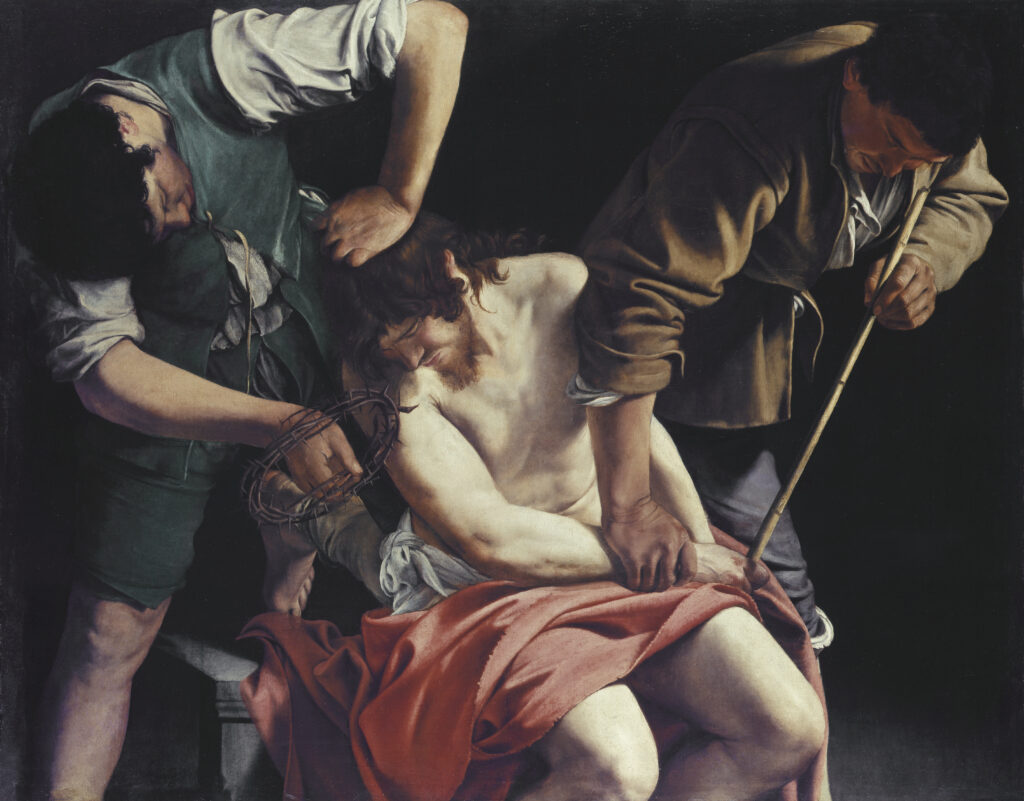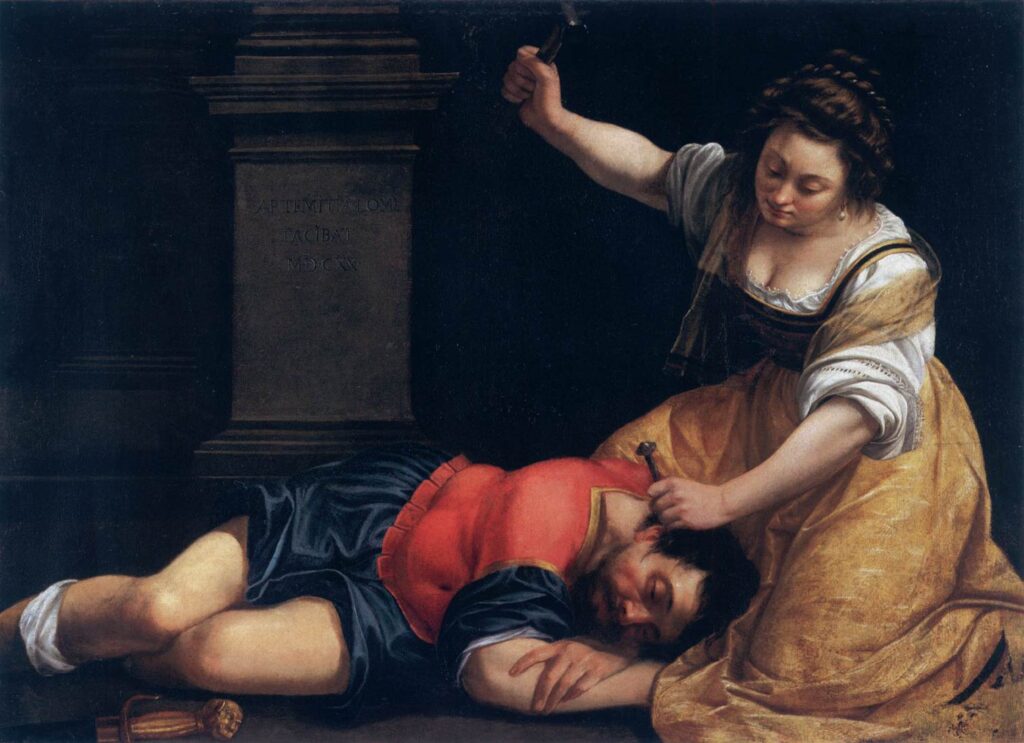Artemisia Gentileschi, born in Rome in 1593, was one of the first women to be a leading painter. That, along with the twentieth-century revival of appreciation for the Italian Baroque, helps to explain the contemporary interest in her. She painted enough pictures showing biblical heroines disposing of male bullies to satisfy any feminist, but such luscious gems as her Sleeping Venus (ca. 1626) or Danae (1612) shows she knew how to please male patrons. This exhibition at Paris’s Musée Jacquemart-André comes only thirteen years after one at the Musée Maillol, also in Paris, which I reviewed in the June 2012 issue of Apollo. Thirteen years is not all that long ago, but, looking back to my article and the Maillol press kit, I found that some attributions have been changed and new discoveries have been made since 2012.
The exhibition calls the painter Artemisia, rather than following the stark, modern habit of calling women only by their last names. This makes sense, since the show gives suitable attention to Artemisia’s father, Orazio Gentileschi, a painter of Tuscan origin, including such paintings of his as the 1613–15 Christ being Crowned with Thorns next to Caravaggio’s own version, The Crowning with Thorns, painted circa 1605. Orazio’s pictureshows the influence that Caravaggio’s naturalism and startling use of light and shadow had on him and on Artemisia in turn. Father and daughter were likewise celebrated in an exhibition at New York’s Metropolitan Museum in 2002, reviewed by Karen Wilkin in The New Criterion of April 2002.

Orazio initially wished for his daughter to enter a convent, but Artemisia, who began drawing as a young child, soon showed that she had inherited her father’s talent and also had plenty of grit. Orazio admitted her to his studio and eventually recommended her to his patrons, among them such figures as Cosimo II of Tuscany, the Duke of Bavaria, Philip IV of Spain, and Charles I of England. Female painters were not as unusual as one might assume: Lavinia Fontana, Sofonisba Anguissola, and others enjoyed careers around the same time. Some patrons felt safer having women paint their daughters, and there may have been an aspect of novelty at work in a woman painter proving her capability.
Artemisia’s darkest moment was in May 1611, two months before her eighteenth birthday, when she was raped by one of her father’s assistants, Agostino Tassi. Orazio had entrusted a servingwoman to look after Artemisia, whose mother died when Artemisia was twelve or thirteen, while he was working elsewhere. Tassi bribed the woman so he could enter Artemisia’s chamber and get his wicked way. Artemisia tried to defend herself with a knife, but she submitted when Tassi promised to marry her. She stayed with him for almost a year until it was discovered that Tassi had a wife elsewhere. When Orazio, described as hotheaded, sued Tassi for the insult to his family’s honor rather than to his daughter’s, Artemisia was forced to undergo humiliating judicial torture.

Even before this ordeal, Artemisia, still in her teens, a young novice as an artist and possibly helped by her father, painted a precocious Susanna and the Elders (1610). Artemisia’s version of the biblical story, unlike Tintoretto’s, makes clear that Susanna hates being pestered by her creepy middle-aged pursuers. Artemisia used her own body in portraying Susanna, as she usually did with female figures, whatever the subject, since the Church frowned on employing nude models. She was to return to Susanna in future paintings. She also repeatedly returned to another biblical tale, Judith’s beheading of Holofernes, a favorite bloody subject of Caravaggio and his followers; Orazio did his own version in 1608–09. Artemisia first took up the subject in 1612, taking a richly Caravaggesque approach, both clinical and ferocious. Judith pushes her dagger into Holofernes’s neck with a technical, surgical determination, while the blood flows onto the bed’s white sheets. She painted another version, Judith and Her Maidservant, around1615. This time the deed has already been done, and the lifeless, decapitated head of Holofernes is stored in a small wicker basket. In 1620, she painted a scene of the biblical heroine, Jael, murdering a defeated Canaanite general, Sisera, while he sleeps by hammering a tent peg into his head. Sisera resembles Holofernes’s head, though one bearded head looks much like any other. The painting’s color scheme and Sisera’s rather revolting pink-red tunic and blue dress recall the work of the Mannerists, whose influence still lingered in Florence. In contrast, the resolute Jael is appealing in her luscious golden gown.

Artemisia showed herself to be remarkable in other ways, too. She was barely taught to read or write in her Roman childhood. A woman painter needed to be married to another painter in order to work, so Orazio fixed up Artemisia with a Florentine painter, Pierantonio Stiattesi, who took her to his hometown. In her Florence years, 1613–20, she learned how to read, write, and play the lute while mingling with Grand Duke Cosimo II’s cultivated set, which included Galileo. Michelangelo’s grandnephew commissioned her to paint Allegory of Inclination (1615–16) on the ceiling of the gallery in his residence at the Casa Buonarroti. The exhibition shows the sparkling painting, in which she depicted a young woman—who resembles Artemisia herself—covered only by loose drapery and set against a pale blue sky, in contrast to her frequently Caravaggesque style. Her patron and friend liked her work enough to pay her more than he paid her male colleagues. She enjoyed a passionate affair with a Florentine noble and man of letters, Francesco Maria Maringhi, while her husband looked the other way because Maringhi was useful to the couple. Artemisia also wrote poetry, and her Self-Portrait as a Lute Player (ca. 1614–15) shows her strumming that most elegant of instruments, perhaps to her own lyrics. The artist’s business sense also allowed her to create her own company later in life and thrive. Even so, in Rome and Florence, she was often in debt and asking for patrons’ help. Her passionate love letters to Maringhi appear to have been tempered by complaints when he was slow to send her money. Her several talents in addition to her importance as a painter proved her a woman of many facets.
Despite Artemisia’s successes in Florence, her debts there overwhelmed her enough that she and her husband had to bolt to Rome and later to Naples with a sojourn in Venice. In Rome, she made friends with the underrated French painter Simon Vouet, who brilliantly painted her, circa 1622–26, with an amused, knowing expression, dressed in a yellow tunic and a blue velvet belt. This illuminating show presents a full picture of Artemisia Gentileschi, a painter with various guises and many talents.
















